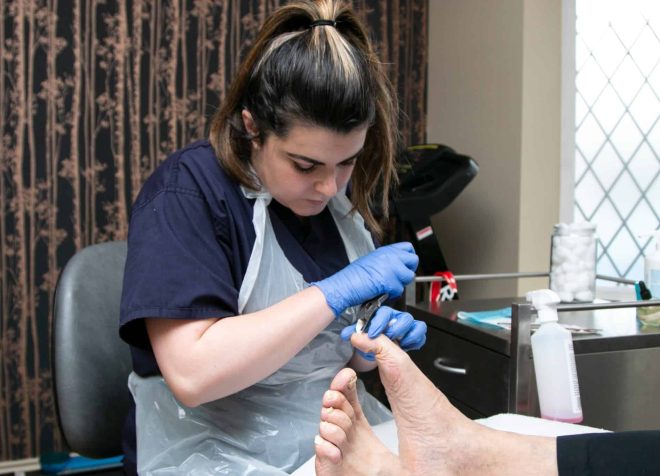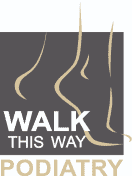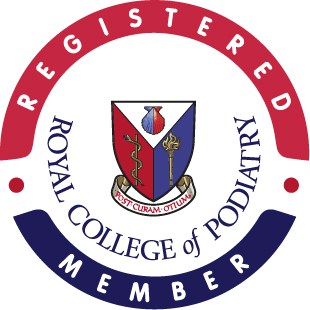Toenails, Callus and Corns
Having invested in the most advanced podiatry technology, our expert team of podiatrists can provide advice and treatment for foot concerns such as toenail trauma, corns, calluses, blisters and cracked heels.

Toenails
Problems with toenails can affect people of all ages. However, they tend to be more common as you age. Causes of toenail problems include trauma, ill-fitting shoes, poor circulation, poor nerve supply and infection.
Fungal nail infections usually occur underneath the nail before spreading to the top. When experiencing toenail fungal infections, you may see a discolouration beneath the nail —usually brown, white, or yellow — thickening of the nail, loosening or separation of the infected part of the nail and a crumbling appearance.
On the other hand, toenail trauma can be chronic or occur as a result of an acute injury, which affects the nail’s growth centre or matrix. As a result, you can experience blood and bruising beneath the toenail, toenail thickening, or toenail loss.
Changes in your toenails can indicate the development of other medical conditions. Therefore, you must seek professional advice as soon as you become aware of any abnormality affecting your toenails.
Damaged toenails
Toenail trauma can result in missing or damaged nails. This can happen due to various reasons such as injury, fungal infections, or autoimmune diseases. In some cases, the nail may grow back on its own, while in other cases, medical treatment may be necessary.
Blisters
Blisters are fluid-filled pockets that form on the skin due to rubbing or pressure. They can be painful and increase the risk of infection if not treated properly. To prevent blisters, it’s important to wear properly fitted shoes and socks and to keep the feet dry.
Cracked heels
Cracked heels can be caused by dry skin, ageing, and excessive pressure on the feet. They can be painful and increase the risk of infection. Treatment options include using moisturising creams or ointments, wearing proper footwear, and using a foot file to gently remove dead skin. In severe cases, medical treatment may be necessary.
Corn and calluses
Corns and calluses are layers of thick and hardened skin that can develop on your feet as a reaction to friction, pressure, and other forms of tear and wear.
Most commonly affecting feet and hands, both corn and calluses are naturally generated by your body as a barrier to protect your skin against injury.
In most cases, calluses aren’t a problem unless they bother you. Corns, on the other hand, often cause severe pain, interfering with your lifestyle.
Even when the pain is bearable, corn and calluses can make walking uncomfortable, affecting the even distribution of body weight in your feet and, as a result, your gait. Subsequently, an altered gait can lead to back, knee or hip pain in the long run.
What’s the difference between corn and calluses?
Despite both resulting from friction, corns and calluses are actually quite different.
Calluses are flat patches of hard, thickened skin that most frequently appear on the heel, ball, or any part of the foot where there is repeated pressure and friction. They often have a yellowish colour and tend to be larger than corns. Calluses have little — if any — sensitivity when touched compared to the normal skin around them. If a callus develops cracks, called fissures, they can become painful.
Corns, on the other hand, are smaller, round-shaped patches of thickened skin with a distinct hard centre and are surrounded by inflamed skin. Because of the inflammation, corns can be uncomfortable without touching them and become very painful when pressure is applied. Unlike calluses, corns usually occur in the areas of your foot that are more likely to experience pressure, e.g. the sides of your small toes, the corner of your nail, between your toes and the soles of your feet.
There are different types of corns:
- Hard corns tend to be small and circular and co-exist with calluses. They develop where a bone comes into direct contact with the inside of a shoe; hence they are typically located on dry, flat areas of skin, especially the bony parts of the foot that are tightly compressed in shoes.
- Soft corns most often develop on the moist skin between your toes, especially the fifth and fourth toes. They tend to be very sensitive and tender and have a supple texture. They usually appear in response to abnormal friction, such as compressing your toes in tight, pointed-toe shoes.
- Seed corns is the term used to refer to a cluster of small corns that can develop on the balls or heels.
What are the symptoms of corns and calluses?
Some of the symptoms you may experience with corns and calluses are:
- A significant amount of pain or discomfort when pressure is applied
- Dense patches of skin buildup in the areas that receive more pressure
- Tenderness/burning around raised portions of skin
- Drier, flaky skin outside the surface of a callus as moisture struggles to penetrate the thick layers of skin.
If left untreated, after some time and prolonged irritation, a brown, red, or black discolouration may develop under a large corn or callus. This change of colour is caused by a small amount of bleeding in the space between thick and normal skin. In severe cases, bleeding can lead to a wound or ulcer and, ultimately, an infection.
What causes corns and calluses?
When the weight of your body is not distributed evenly around your feet, they have to adjust your gait to keep you in balance. This adjustment can cause friction or pressure in particular areas of your feet, leading to the development of corns and calluses. If your foot structure is out of alignment or there is a biomechanical problem, the appearance of corns and calluses can simply be a symptom of this problem.
The most common reasons for corns and calluses are:
- Misalignment in your foot so your gait (walking style) puts pressure on specific parts of the foot
- Biomechanical problems in your foot.
- Ill-fitting shoes. When your regular footwear is too tight, the constant pressure and friction cause your skin to thicken. If, by contrast, your shoes are too loose, then your feet will repeatedly rub against the shoe, causing friction.
- Not wearing socks with your shoes which again creates more friction on the skin.
Seeking professional advice from our expert team of podiatrists not only enables you to get rid of any corns or calluses that are bothering you but also find a solution to help you prevent them from recurring.








